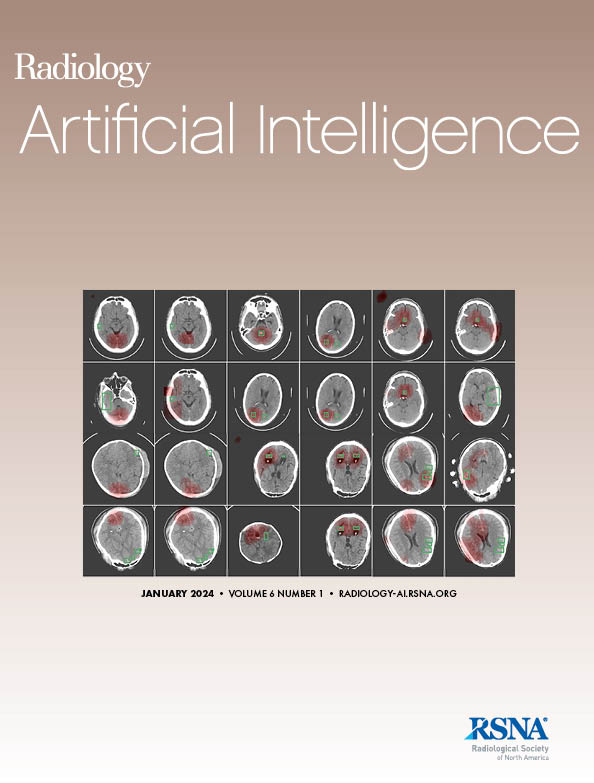Chaojie Zhang, Shengjia Chen, Ozkan Cigdem, Haresh Rengaraj Rajamohan, Kyunghyun Cho, Richard Kijowski, Cem M Deniz
下载PDF
{"title":"MR-Transformer:一种基于视觉变压器的深度学习模型,用于MRI全膝关节置换术预测。","authors":"Chaojie Zhang, Shengjia Chen, Ozkan Cigdem, Haresh Rengaraj Rajamohan, Kyunghyun Cho, Richard Kijowski, Cem M Deniz","doi":"10.1148/ryai.240373","DOIUrl":null,"url":null,"abstract":"<p><p>Purpose To develop a transformer-based deep learning model-MR-Transformer-that leverages ImageNet pretraining and three-dimensional spatial correlations to predict the progression of knee osteoarthritis to total knee replacement using MRI. Materials and Methods This retrospective study included 353 case-control matched pairs of coronal intermediate-weighted turbo spin-echo (COR-IW-TSE) and sagittal intermediate-weighted turbo spin-echo with fat suppression (SAG-IW-TSE-FS) knee MRI scans from the Osteoarthritis Initiative database, with a follow-up period up to 9 years, and 270 case-control matched pairs of coronal short-tau inversion recovery (COR-STIR) and sagittal proton-density fat-saturated (SAG-PD-FAT-SAT) knee MRI scans from the Multicenter Osteoarthritis Study database, with a follow-up period up to 7 years. Performance of the MR-Transformer to predict the progression of knee osteoarthritis was compared with that of existing state-of-the-art deep learning models (TSE-Net, 3DMeT, and MRNet) using sevenfold nested cross-validation across the four MRI tissue sequences. Results Among the 353 Osteoarthritis Initiative case-control pairs, 215 were women (mean age, 63 years ± 8 [SD]); among the 270 Multicenter Osteoarthritis Study case-control pairs, 203 were women (mean age, 65 years ± 7). The MR-Transformer achieved areas under the receiver operating characteristic curve (AUCs) of 0.88 (95% CI: 0.85, 0.91), 0.88 (95% CI: 0.85, 0.90), 0.86 (95% CI: 0.82, 0.89), and 0.84 (95% CI: 0.81, 0.87) for COR-IW-TSE, SAG-IW-TSE-FS, COR-STIR, and SAG-PD-FAT-SAT, respectively. The model achieved a higher AUC than that of 3DMeT for all MRI sequences (<i>P</i> < .001). The model showed the highest sensitivity of 83% (95% CI: 78, 87) and specificity of 83% (95% CI: 76, 88) for the COR-IW-TSE MRI sequence. Conclusion Compared with the existing deep learning models, the MR-Transformer exhibited state-of-the-art performance in predicting the progression of knee osteoarthritis to total knee replacement using MRI scans. <b>Keywords:</b> MRI, Knee, Prognosis, Supervised Learning <i>Supplemental material is available for this article.</i> © RSNA, 2025.</p>","PeriodicalId":29787,"journal":{"name":"Radiology-Artificial Intelligence","volume":" ","pages":"e240373"},"PeriodicalIF":13.2000,"publicationDate":"2025-09-01","publicationTypes":"Journal Article","fieldsOfStudy":null,"isOpenAccess":false,"openAccessPdf":"https://www.ncbi.nlm.nih.gov/pmc/articles/PMC12464714/pdf/","citationCount":"0","resultStr":"{\"title\":\"MR-Transformer: A Vision Transformer-based Deep Learning Model for Total Knee Replacement Prediction Using MRI.\",\"authors\":\"Chaojie Zhang, Shengjia Chen, Ozkan Cigdem, Haresh Rengaraj Rajamohan, Kyunghyun Cho, Richard Kijowski, Cem M Deniz\",\"doi\":\"10.1148/ryai.240373\",\"DOIUrl\":null,\"url\":null,\"abstract\":\"<p><p>Purpose To develop a transformer-based deep learning model-MR-Transformer-that leverages ImageNet pretraining and three-dimensional spatial correlations to predict the progression of knee osteoarthritis to total knee replacement using MRI. Materials and Methods This retrospective study included 353 case-control matched pairs of coronal intermediate-weighted turbo spin-echo (COR-IW-TSE) and sagittal intermediate-weighted turbo spin-echo with fat suppression (SAG-IW-TSE-FS) knee MRI scans from the Osteoarthritis Initiative database, with a follow-up period up to 9 years, and 270 case-control matched pairs of coronal short-tau inversion recovery (COR-STIR) and sagittal proton-density fat-saturated (SAG-PD-FAT-SAT) knee MRI scans from the Multicenter Osteoarthritis Study database, with a follow-up period up to 7 years. Performance of the MR-Transformer to predict the progression of knee osteoarthritis was compared with that of existing state-of-the-art deep learning models (TSE-Net, 3DMeT, and MRNet) using sevenfold nested cross-validation across the four MRI tissue sequences. Results Among the 353 Osteoarthritis Initiative case-control pairs, 215 were women (mean age, 63 years ± 8 [SD]); among the 270 Multicenter Osteoarthritis Study case-control pairs, 203 were women (mean age, 65 years ± 7). The MR-Transformer achieved areas under the receiver operating characteristic curve (AUCs) of 0.88 (95% CI: 0.85, 0.91), 0.88 (95% CI: 0.85, 0.90), 0.86 (95% CI: 0.82, 0.89), and 0.84 (95% CI: 0.81, 0.87) for COR-IW-TSE, SAG-IW-TSE-FS, COR-STIR, and SAG-PD-FAT-SAT, respectively. The model achieved a higher AUC than that of 3DMeT for all MRI sequences (<i>P</i> < .001). The model showed the highest sensitivity of 83% (95% CI: 78, 87) and specificity of 83% (95% CI: 76, 88) for the COR-IW-TSE MRI sequence. Conclusion Compared with the existing deep learning models, the MR-Transformer exhibited state-of-the-art performance in predicting the progression of knee osteoarthritis to total knee replacement using MRI scans. <b>Keywords:</b> MRI, Knee, Prognosis, Supervised Learning <i>Supplemental material is available for this article.</i> © RSNA, 2025.</p>\",\"PeriodicalId\":29787,\"journal\":{\"name\":\"Radiology-Artificial Intelligence\",\"volume\":\" \",\"pages\":\"e240373\"},\"PeriodicalIF\":13.2000,\"publicationDate\":\"2025-09-01\",\"publicationTypes\":\"Journal Article\",\"fieldsOfStudy\":null,\"isOpenAccess\":false,\"openAccessPdf\":\"https://www.ncbi.nlm.nih.gov/pmc/articles/PMC12464714/pdf/\",\"citationCount\":\"0\",\"resultStr\":null,\"platform\":\"Semanticscholar\",\"paperid\":null,\"PeriodicalName\":\"Radiology-Artificial Intelligence\",\"FirstCategoryId\":\"1085\",\"ListUrlMain\":\"https://doi.org/10.1148/ryai.240373\",\"RegionNum\":0,\"RegionCategory\":null,\"ArticlePicture\":[],\"TitleCN\":null,\"AbstractTextCN\":null,\"PMCID\":null,\"EPubDate\":\"\",\"PubModel\":\"\",\"JCR\":\"Q1\",\"JCRName\":\"COMPUTER SCIENCE, ARTIFICIAL INTELLIGENCE\",\"Score\":null,\"Total\":0}","platform":"Semanticscholar","paperid":null,"PeriodicalName":"Radiology-Artificial Intelligence","FirstCategoryId":"1085","ListUrlMain":"https://doi.org/10.1148/ryai.240373","RegionNum":0,"RegionCategory":null,"ArticlePicture":[],"TitleCN":null,"AbstractTextCN":null,"PMCID":null,"EPubDate":"","PubModel":"","JCR":"Q1","JCRName":"COMPUTER SCIENCE, ARTIFICIAL INTELLIGENCE","Score":null,"Total":0}
引用次数: 0
引用
批量引用

 求助内容:
求助内容: 应助结果提醒方式:
应助结果提醒方式:


